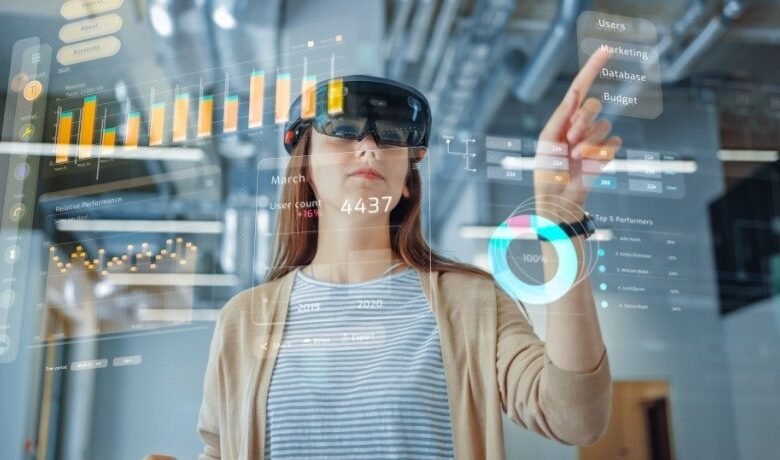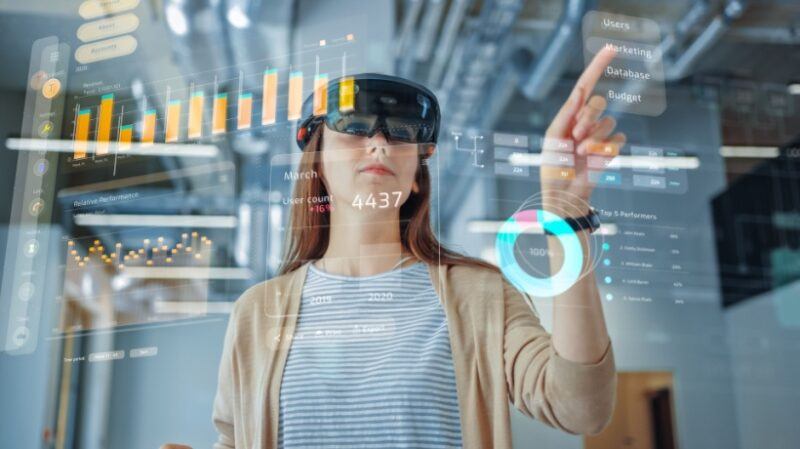Augmented Reality And Virtual Reality In eLearning


AR Vs. VR: What’s The Difference?
Goldman Sachs predicts that the AR and VR technology market will skyrocket to nearly $95 billion by 2025. Even before COVID-19, schools, universities, and corporate training facilities were already exploring the possibilities of Augmented Reality (AR) and Virtual Reality (VR) in their training programs. These technologies were seen as innovative tools that could enhance traditional learning methods and provide more immersive and interactive educational experiences. However, the onset of the COVID-19 pandemic has accelerated the adoption of Augmented Reality and Virtual Reality in eLearning. With lockdowns, social distancing, and remote learning becoming the norm, the need for effective and engaging digital learning solutions has become more critical than ever. AR and VR offer unique advantages that traditional online learning platforms cannot match. Those two technologies often get lumped together, but they’re actually quite different. Both technologies are game-changers, yet they serve distinct purposes and have unique goals. Let’s break it down.
The Differences Between AR And VR
Virtual Reality (VR)
- Technology
VR relies on opaque headsets. - Experience
It completely immerses users in a virtual world by blocking out the real world. - Use Case
Great for creating fully immersive experiences, such as simulations or virtual tours.
Augmented Reality (AR)
- Technology
AR overlays digital elements onto the live view of the real world. - Experience
It enhances the real world by adding digital components, allowing users to interact with both simultaneously. - Use Case
Ideal for applications that require users to stay aware of their surroundings, such as construction, education, and retail.
In essence, VR offers a completely immersive virtual experience, while AR integrates digital elements into the real world, enhancing your surroundings.
Practical Ways Of Using Augmented Reality And Virtual Reality In eLearning
1. Digital Classrooms And Field Trips
With a 360-degree camera, educators can create immersive VR recordings that transform the learning experience. Many teachers are already harnessing this technology to develop engaging and interactive learning materials. If a student misses a lab, lecture, or field trip, they can simply view the VR recordings to catch up. This approach also provides valuable visual feedback, enhancing the learning process. If learners struggle with a particular concept or step, VR simulations allow them to practice repeatedly until they master the material and pass their assessments. This hands-on practice in a virtual environment can be incredibly effective.
AR and VR can also incorporate gamification elements into the training process, making learning more engaging and enjoyable. These technologies keep the experience safe, controllable, and easy to monitor. This not only improves learning outcomes but also reduces the time and costs associated with consumables, commuting, and other resources. Overall, integrating AR and VR into education can revolutionize the way students learn, providing them with immersive and flexible learning opportunities.
2. Safety Training
By integrating AR into your eLearning courses about office or construction safety, you can significantly enhance your staff’s learning experience. Deliver the course through a mobile eLearning app that supports AR. As employees listen to audio or watch a video of an instructor on the app, they can use their smartphones to scan their surroundings in the office or construction site. The AR app will then overlay crucial safety information directly onto their real-world environment. Employees will see evacuation paths, emergency exits, hazard zones, and safety protocols clearly displayed on their screens.
3. Employee Onboarding
AR and VR technologies can revolutionize the employee onboarding process. Imagine a new hire arriving at the office and struggling to locate where each person sits. Instead of wandering around aimlessly, they can use a pair of smart glasses for assistance. The new hire can simply speak the name of the person they’re looking for or use gestures to indicate their search. The smart glasses then guide them with a combination of audio instructions and visual cues displayed on the lenses. As the new hire walks around the office, the glasses’ facial recognition capabilities help them identify and locate their colleagues.
4. Medical Training
AR can meet the training needs of medical, paramedical, and nursing students and staff. The smart glasses market is expected to grow by about $69 million from 2021–2025, making AR-enabled hardware and software more available and affordable. By overlaying real-world settings with virtual information, AR eLearning helps diagnose and determine the best course of treatment. Adding images of injuries to patient models helps nursing students build diagnostic skills, showing that each decision leads to a specific outcome. This way, they see the simulated consequences of their actions.
AR can also help train doctors, nurses, and other ER staff to operate in crisis scenarios, such as managing an unusual incoming patient flow. It does that by allowing them to practice prioritizing patients based on severity and directing them accordingly. In psychiatry, AR/VR simulations of hallucinations can help aspiring psychiatrists understand and empathize with their patients, improving treatment.
5. Engineering Training
Augmented Reality (AR) is proving to be a game-changer in engineering training across various industries. It helps learners grasp complex systems and structures more effectively. For example, AR in construction allows mechanics in training to learn where each part is, what it does, and how it integrates with others, providing a deeper understanding of mechanical systems. For industrial workers, AR simulations provide a safe environment to learn their tasks, reducing the risk of workplace accidents and injuries.
AR and VR simulations work by overlaying real-world views with virtual information. Users interact with their actual surroundings while AR adds elements like text, links, photos, 2D illustrations, virtual 3D objects, audio clips, or videos. These virtual elements are context-sensitive and can respond to gestures or voice commands, making the learning experience highly interactive.
In construction, AR is particularly beneficial for crane and machine operators. It provides real-time guidance, helping them handle equipment more effectively. Other construction workers also benefit from AR by learning to use their tools and equipment safely and efficiently. By simulating real-life stress and operating conditions, AR enhances learning effectiveness, preparing workers better for their roles.
6. Sales Training
Serious games blend entertainment with education, making them powerful tools for training. Take Pokémon Go, for example; it seamlessly integrates Augmented Reality (AR) into gameplay. Similarly, in corporate training, AR can revolutionize how sales personnel are trained. Imagine a sales representative standing behind a store counter, equipped with smart glasses and an AR app. Through this app, they engage with simulated scenarios involving animated characters posing as customers. For instance, they could practice handling an angry customer using interactive AR elements. The app gamifies the learning experience by awarding points or badges when the representative successfully resolves customer issues or prevents complaints.
7. Language Learning
AR is a versatile tool for learning a new language, whether you’re at home, in the office, or anywhere else. Imagine strolling through a supermarket and using AR to learn new vocabulary relevant to the items around you. Alternatively, during a train journey, you could practice oral or written conversations in a new language with a virtual language teacher.
In the corporate world, AR and VR language-learning apps can transform how global workforces are trained in several ways:
- Placing virtual elements—like labels or audio clips—next to real-world objects using object recognition.
- Displaying animals, objects, and other things in the surroundings with corresponding labels and audio clips.
- Simulating real-life conversations with animated characters that interact with you via chatbot technology and speech recognition.
AR language learning apps revolutionize language acquisition by integrating labels and audio clips that teach the foreign language equivalents of physical objects. Chatbot interactions enable learners to practice pronunciation and fluency across diverse topics. These apps empower users to explore their surroundings, discovering new words and sentences in real time. AI-driven virtual language teachers offer personalized feedback on pronunciation, enhancing the learning experience significantly.
Final Considerations
Wondering if your AR and VR eLearning apps are up to the challenge? Here’s a checklist to help you evaluate:
- High Interactivity
Instead of a passive experience, ensure your app allows users to actively engage with augmented and virtual environments. They should interact by exploring information, manipulating virtual objects, listening to audio, and watching videos. - Realism
Your app should deliver a highly realistic experience where virtual objects look authentic and respond realistically to user actions. Achieve this with high-quality rendering and smooth performance across AR and VR modes. - Strategic Learning Experience
Success hinges on more than technology—it’s about how well the app is designed to achieve specific learning outcomes. Work with skilled learning experience designers to ensure your app effectively supports learning in both AR and VR contexts. - Customization
Tailor your AR and VR eLearning app to fit your training needs, business goals, company culture, and the diverse learning styles and skill levels of your staff. Seamless integration of AR and VR elements enhances engagement and promotes effective learning across different modalities.
This checklist ensures that your AR and VR eLearning app not only engages users but also drives effective learning aligned with your organizational objectives, harnessing the strengths of both augmented and virtual reality technologies.
Source link



